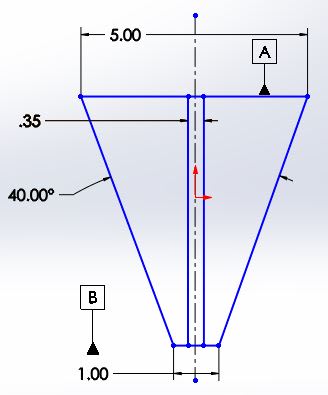greenimi,
My apologies, your question is a complex one and I wanted to make sure I gave it the attention it deserves.
Your inquiry is a valid one, however I think the key difference is the utilization of profile vs runout with self-referencing datums.
Your example of runout with a compound datum (pulled from fig 9-4) I believe is also self-referencing. The only reason why I didn't draw issue with it is runout with self referencing datums is a well established practice and has several examples supporting its use in the standard (9-4, 9-6, 9-7 all have self referencing datums). If you read through some correspondences on the topic (
there seems to be some division on whether it is really proper or "stands up to scrutiny". It makes me wonder if there wouldn't be a better way of specifying such a requirement - though I'm not sure if it is possible with the available tools in Y14.5, the one thing that comes to mind is possibly the new "dynamic profile" modifier that will be coming in the new 2019 standard.
greenimi said:
if I have a runout on a cylindrical surface (call it datum feature A) within 0.01 to A, would you say that is self-referencing or not?
I think with a single feature referencing only itself with runout (not a compound datum like your previous example similar to 9-4) is also self referencing but is confusing at best, and I think in most cases ends up being a form control only. Referencing thread
it seems that it is agreed that typically for total runout it would be equivalent to cylindricity. Circular runout vs. circularity for a single, self-referencing datum seems to be a more complex question.
Reading through that thread it seems that I may differ from some in my definition of "self-referencing", I would consider ANY feature which is controlled with a DRF which includes that feature to be self-referencing - not just ones that result in an invalid combination (ie: position of A relative to A). Maybe more precise terminology is needed to differentiate the two?
greenimi said:
For me looks like an equivalent concept, but not applied to a cylindrical surface (as it is in pmarcs’s conversation) but to a planar one (as applied to OP’s discussion)
The reason I draw issue with the concept (actually I said to avoid it, not that its invalid) as applied to a profile tolerance on a planar feature is that there is no real documentation in the standard on it. From what I can tell, there is somewhat of a consensus that self-referencing datums with profile tolerance results in a "halving" of the available tolerance zone - however this is not a well known topic and in actual practice (inspection and gauging) approaches/interpretations may differ.
Some threads which discuss the topic of self-referencing datums combined with profile. I realize your example is slightly different (B and C controlled separately with B-C instead of both B and C controlled together with B-C) however I think the result is the same - if not even more difficult to interpret.

